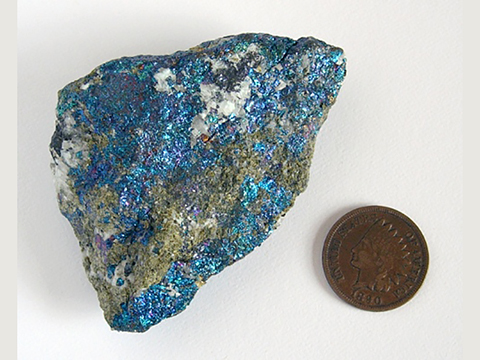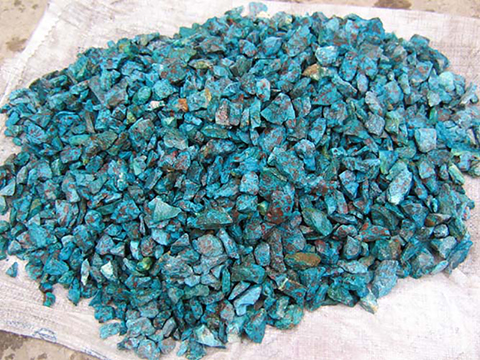Part B
Copper Ores & Their Metal Abundances
There are many different copper ores, but most are either copper sulfides or copper oxides. Although these minerals have different composition and contain different percentages of copper, they all have one thing in common: copper! But is there enough copper to make it worth mining?
|
Figure 13-7. Copper ore minerals include the sulfide bornite (left) and the oxide chrysocolla (right). |
|
Copper Sulfides & Oxides
As summarized in Lab 4, copper minerals occur in two main groups: sulfides and oxides. Copper can combine with sulfur to form copper sulfides (like chalcopyrite) that often have a metallic luster. Copper oxides are formed when a copper sulfide ore deposit weathers, and the copper combines with oxygen, typically giving these minerals distinctive colors (like azurite-blue, malachite-green, etc.).Some common copper minerals are described below.
![]() Chalcopyrite / CuFeS2 / Metallic luster. Relatively soft (H = 3.5 to 4), so it can be scratched with a steel nail, but not with a fingernail. Commonly massive and does not form nice crystals. SG = 4.1 to 4.3. Golden to brassy yellow color that can tarnish bluish-purple.
Chalcopyrite / CuFeS2 / Metallic luster. Relatively soft (H = 3.5 to 4), so it can be scratched with a steel nail, but not with a fingernail. Commonly massive and does not form nice crystals. SG = 4.1 to 4.3. Golden to brassy yellow color that can tarnish bluish-purple.
![]() Bornite / Cu5FeS4 / Metallic luster. Dark gray streak. Soft (H = 3), so it can be scratched with a steel nail, but not with a fingernail. Massive. SG = 5.1. Iridescent blue, purple or copper red color that often tarnishes dark purple. "Peacock ore".
Bornite / Cu5FeS4 / Metallic luster. Dark gray streak. Soft (H = 3), so it can be scratched with a steel nail, but not with a fingernail. Massive. SG = 5.1. Iridescent blue, purple or copper red color that often tarnishes dark purple. "Peacock ore".
![]() Azurite / Cu3(CO3)2(OH)2 / Nonmetallic luster. Light blue streak. Relatively soft (H = 3.5 to 4), so it can be scratched with a steel nail, but not with a fingernail. Generally forms earthy masses. SG = 2.7 to 3.1. Distinctive light to deep blue color.
Azurite / Cu3(CO3)2(OH)2 / Nonmetallic luster. Light blue streak. Relatively soft (H = 3.5 to 4), so it can be scratched with a steel nail, but not with a fingernail. Generally forms earthy masses. SG = 2.7 to 3.1. Distinctive light to deep blue color.
![]() Chrysocolla / CuSiO3*H2O / Nonmetallic luster. Very light blue streak. Soft (H = 2 to 4), so it can be scratched with a steel nail, but may or may not with a fingernail. Generally forms earthy masses. SG = 2.0 to 2.4. Pale blue-green or turquoise color.
Chrysocolla / CuSiO3*H2O / Nonmetallic luster. Very light blue streak. Soft (H = 2 to 4), so it can be scratched with a steel nail, but may or may not with a fingernail. Generally forms earthy masses. SG = 2.0 to 2.4. Pale blue-green or turquoise color.
![]() Malachite / Cu2(CO3)(OH)2 / Nonmetallic luster. Green streak. Soft (H = 3.5 to 4), so it can be scratched with a steel nail, but may or may not with a fingernail. Generally forms earthy masses. SG = 3.9 to 4.0. Distinctive pale to dark green color.
Malachite / Cu2(CO3)(OH)2 / Nonmetallic luster. Green streak. Soft (H = 3.5 to 4), so it can be scratched with a steel nail, but may or may not with a fingernail. Generally forms earthy masses. SG = 3.9 to 4.0. Distinctive pale to dark green color.
![]() Native copper / Cu / Metallic luster. Copper streak. Relatively soft (H = 2.5 to 3), so it can be scratched with a steel nail, but may or may not with a fingernail. Malleable (can be bent without breaking, like wire). Generally massive or dendritic (root-like). SG = 8.8. Copper color (like a new penny), but tarnishes dull brown or green (like an old penny).
Native copper / Cu / Metallic luster. Copper streak. Relatively soft (H = 2.5 to 3), so it can be scratched with a steel nail, but may or may not with a fingernail. Malleable (can be bent without breaking, like wire). Generally massive or dendritic (root-like). SG = 8.8. Copper color (like a new penny), but tarnishes dull brown or green (like an old penny).
Identifying Copper Minerals
Most copper minerals can be identified using a few important physical properties, like color, luster, hardness, etc. Since most copper minerals have metallic luster or distinct color, you can use the same identification methodology (luster/hardness/streak) that you used in Lab 4. To summarize:
> Luster - First, determine the mineral's luster (metallic or non-metallic).
> Hardness - The next property to check the mineral's hardness (by scratching it with your fingernail, a penny, a steel nail, etc.).
> Streak - After this, you can look at the color of the mineral's streak.
> Other - Lastly, any other characteristic properties can be added to your observations (like color, effervescence, magnetism, cleavage, crystal form, etc.).
Quiz Me! questions B20 through B24 involve mineral identification. You'll recognize some distinctive minerals right away because, but others may require more in-depth study of the mineral descriptions, mineral images, or even the mineral Lab 4 identification charts. Be sure to make use of any hints.
![]()
![]()
![]()
![]()
![]()
Calculating Weight Percent Copper in a Mineral
Copper ores have different grades that are determined by their percentage of copper. To find the value of a mineral, you must first determine the amount (weight percent) of metal in the mineral.
|
Example 1 |
|
Determine the amount (weight %) of copper in chalcocite (Cu2S). |
|
1) Use the Periodic Table of the Elements (SEE HERE) to find the atomic weights for all the elements present in the mineral. Round the atomic weights for each element to nearest whole number. The elements in chalcocite (Cu2S) are: copper (Cu) sulfur (S) The atomic weights for these elements: copper (Cu) = 64 sulfur (S) = 32
2) Get the total atomic weight for each element. If a subscript number is attached directly to an element (like Cu2), then multiply the element's atomic weight by that subscript number (64 x 2). chalcocite (Cu2S) = 2 Cu + 1 S copper (Cu): 64 x 2 = 128 sulfur (S): 32 x 1 = 32
3) Calculate the total atomic weight of chalcocite by adding all atomic weights together. chalcocite total atomic weight = (128 + 32) = 160
4) Divide the atomic weight copper (128 in this case) by the total atomic weight (160) and then multiply by 100 to give the weight % copper in chalcocite.Thus, the weight percent copper in the mineral chalcocite is: (128 / 160) x 100 = 80%
|
For a mineral with a more complex formula, like malachite (Cu2(CO3)(OH)2), you must watch out for parentheses. If a number is inside the parentheses, it is multiplied times only the element it follows. If a number is outside of the parentheses, it is multiplied times all the elements inside the parentheses.
|
Example 2 |
|
Determine the amount of copper in malachite (Cu2(CO3)(OH)2). |
|
1) Use the Periodic Table of the Elements (SEE HERE) to find the atomic weights for all the elements present in the mineral. Round the atomic weights for each element to nearest whole number. The elements in malachite (Cu2(CO3)(OH)2) are: copper (Cu) carbon (C) oxygen (O) hydrogen (H)
The atomic weights for these elements: copper (Cu) = 64 carbon (C) = 12 oxygen (O) = 16 hydrogen (H) = 1
2) Get the total atomic weight for each element. Again, if a subscript number is attached directly to an element (like Cu2), then multiply the element's atomic weight by that subscript number (64 x 2). Additionally, if a subscript number is attached OUTSIDE the parentheses (like (OH)2), then multiply the atomic weight of each element inside the parentheses by that subscript number (16 x 2 and 1 x 2). malachite (Cu2(CO3)(OH)2) copper (Cu): 64 x 2 = 128 carbon (C) = 12 x 1 = 12 oxygen (O) = (16 x 3) + (16 x 2) = 80 hydrogen (H): 1 x 2 = 2
3) Calculate the total atomic weight of malachite by adding all atomic weights together. malachite total atomic weight = copper (128) + carbon (12) + oxygen (80) = hydrogen (2) = 222
3) Divide the atomic weight copper (128) by the total atomic weight (222) and multiply by 100 to give the weight percent copper in malachite. Thus, the weight percent copper in the mineral malachite is: (128 / 222) x 100 = 58%
|
Now, you try it. Write out the problems in the format shown above and use a calculator to determine the weight percent copper in each mineral. To simplify matters, use the following atomic weights in your calculations (H = 1, C = 12, O = 16, Si = 28, S = 32, Fe = 56, Cu = 64) and round your answer to the nearest whole number.
![]()
![]()
![]()
![]()
![]()
![]()

